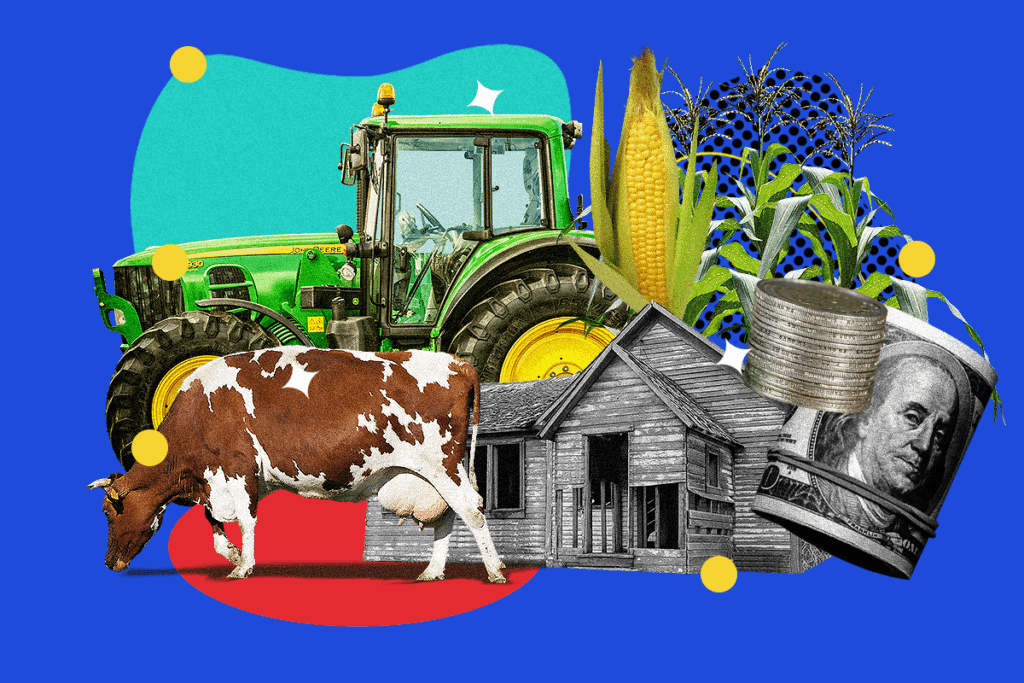Add Farmland Exposure to Your Portfolio in 2022 With These Top Agriculture ETFs
Add agriculture exposure to your portfolio with the best farmland ETFs, including DBA, CORN, and TAGS.

Farmland has long been an underrated asset, largely because it’s historically been unavailable to your everyday investor. Not only is farmland one of the most secure assets, it also provides diversification benefits and can help you build a more recession-resistant portfolio.
Farmland is an uncorrelated asset, which means it doesn’t necessarily follow the same patterns as the stock market. In other words, if the market crashes, farmland investments may help you maintain the value of your portfolio.
Thanks to farmland ETFs, it’s now possible for just about anyone to add agricultural exposure to their portfolio. Keep in mind that these are all futures-based ETFs, and futures and options contracts can be a risky endeavor for investors with little experience. If you know what you’re doing, though, the best farmland ETFs can add security and diversification to your portfolio. Here are some of the best agriculture ETFs in 2021 and how you can invest in them.
Comparing the best farmland ETFs
| Invesco DB Agriculture Fund (DBA) | Teucrium Corn Fund ETV (CORN) | Teucrium Agricultural Fund (TAGS) | Elements Rogers International Commodity Index-Agriculture ETN (RJA) | iPath Series B Bloomberg Grains Subindex Total Return ETN (JJG) | |
|---|---|---|---|---|---|
| Share Price | |||||
| YTD Total Returns | |||||
| 5-Year Average Annual Return | |||||
| AUM | $2.36B | $289.08M | $52.70M | $255.59M | $62.16M |
Invesco DB Agriculture Fund (DBA)
- Commodity: Agriculture
- Inception year: 2007
- Expense ratio: 0.94%
With nearly $1 billion in assets under management, DBA is the biggest farmland ETF by a wide margin. While long-term returns aren’t quite as high as those offered by some of the other best farmland ETFs, this fund is well-established and designed for short-term investors willing to take on the risk of investing in futures contracts. DBA tracks an index of 10 futures contracts in the agricultural sector. Its holdings include wheat, corn, soybeans, livestock, sugar, coffee, cocoa, cattle, and more, making this one of the best farmland ETFs for gaining broad exposure to a wide range of agricultural commodities.
Teucrium Corn Fund ETV (CORN)
- Commodity: Corn
- Inception year: 2010
- Expense ratio: 2.19%
The Teucrium Corn Fund tracks an index of various corn futures contracts. While CORN doesn’t offer the broad exposure that a general agricultural ETF would, it’s one of the best farmland ETFs for exposure to corn futures. It’s performed comparatively well both in 2021 and over the past five years. If you’re experienced enough for futures contracts, CORN also offers a relatively easy way to add corn exposure to your portfolio, which is a crucial US commodity that can help investors hedge against inflation.
Teucrium Agricultural Fund (TAGS)
- Commodity: Agriculture
- Inception year: 2012
- Expense ratio: 0.21%
Teucrium Agricultural Fund actually combines four of the best farmland ETFs into one fund: CANE, SOYB, WEAT, and CORN, all issued by Teucrium. Thus by investing in TAGS, you’re gaining exposure to four different agricultural commodities—sugar, soybeans, wheat, and corn—in equal weight. Again, these are all investments in futures contracts, which can be risky.
Elements Rogers International Commodity Index (RJA)
- Commodity: Agriculture
- Inception year: 2007
- Expense ratio: 0.75%
The Elements Rogers International Commodity Index is actually an exchange-traded note (ETN), which is a debt security issued by a bank. Still, the RJA ETN functions similarly to the other farmland ETFs on this list in that it tracks a range of agricultural commodities by investing in 21 different futures contracts.
Corn, wheat, cotton, and soybeans are weighted heavily, and feedstock and livestock are also included. RJA makes for a good short-term investment for experienced investors. Despite the poor performance of agricultural commodities prices over the last five years, RJA has managed average annualized returns over the last five years of 5.53% when even the best agriculture ETFs have struggled to come close to that.
iPath Series B Bloomberg Grains Subindex Total Return ETN (JJG)
- Commodity: Grains
- Inception year: 2018
- Expense ratio: 0.45%
Also an ETN, the iPath Series B Bloomberg Grains Subindex Total Return ETN (JJG) tracks an underlying grains index. The index includes futures contracts for five different grains: wheat, soybeans, soybean oil, corn, and soybean meal. Investors get cash payments when the notes mature, which happens within one to five months.
This is a newer fund, but in a few short years it’s already accumulated $21.6 million in assets under management.
How to buy the best farmland ETFs
You can buy farmland ETFs with most major online brokers and robo advisors. For example, investing app SoFi lets you buy stocks and ETFs pretty easily and charges no trading fees. The investment minimum is just $5, and you can buy shares from your mobile phone on their user-friendly app.
What is the best way to invest in farmland?
While farmland ETFs and REITs make investing in farmland easy and convenient, they don’t directly mirror the benefits of owning farmland directly. Often, ETFs and public REITs follow patterns similar to the stock market, so they don’t offer diversification benefits to the same extent as owning farmland, which is an uncorrelated asset that can protect your portfolio against market downturns. One of the best ways to invest directly in farmland without having to purchase it yourself is to go through a platform like FarmTogether that lets you invest directly in income-generating individual farms with as little as $10,000.
Frequently asked questions
How can I invest in agricultural land?
There are a number of different ways to invest in agricultural land and agricultural commodities, and investing in the best farmland ETFs is just one of those ways. You can also buy shares in a farmland REIT or purchase farmland yourself directly. Finally, you can go through a farmland investing app like FarmTogether to invest in individual farms without having to purchase land and manage it yourself.
Are there any farmland ETFs?
There are dozens of apps that let you invest in real estate. Some of these apps have very low investment minimums (as low as $1) and allow almost anyone to start investing in real estate with the click of a few buttons. Other real estate apps for investors have higher minimum investment requirements ($1,000+) and may only be open to accredited investors.
What is an agricultural ETF?
An agricultural ETF is an exchange-traded fund that invests in farmland and/or agricultural commodities such as grains, livestock, sugar, cattle, and more. They offer an easy way for investors to add exposure to agriculture to their portfolio with the built-in benefit of diversification.
Is investing in farmland worth it?
Investing in farmland can help you build a more recession-resistant portfolio so your wealth survives market downturns. It’s a fairly stable, secure asset that tends to hold value well over time. After all, we always need to eat, even during the worst economic crises.
Are there farmland REITs?
There are a few farmland real estate investment trusts (REITs) that hold a diversified portfolio of real estate investments in the agricultural sector. Investors can buy shares in these farmland REITs similar to how you can buy shares in a company.
